April 18, 2025 | 08:22 GMT +7
April 18, 2025 | 08:22 GMT +7
Hotline: 0913.378.918
April 18, 2025 | 08:22 GMT +7
Hotline: 0913.378.918
According to the Plant Protection Department (PPD), the banana is a plant with high export potential, bringing high economic value. In 2019 the country has had 150 thousand hectares of banana, in which about 70 thousand hectares are in the Northern region, and about 80 thousand hectares are in the Southern region.
In recent years, banana yellow leaf wilt disease (also known as Panama wilt disease), caused by the fungus Fusarium oxysporum f.sp. cubense Tropical strain 4 (Foc.TR4 in short), has appeared in Vietnam, causing damage in many localities. This dihttps://nongnghiepmoitruong.vn/quy-trinh-phong-chong-benh-heo-vang-la-chuoi-d290944.htmlsease makes banana plants wilt yellow, decreases yield and causes banana gardens to wither after 2-3 years. While Strain 1 of the fungus only causes small damage on Awak bananas (porcelain bananas, Siamese bananas) in all banana growing areas in the country, this Strain 4 is harmful to the Cavendish banana group such as ‘Tieu Gia’, ‘Tieu Hong’ banana and other banana varieties susceptible to Strain 1.
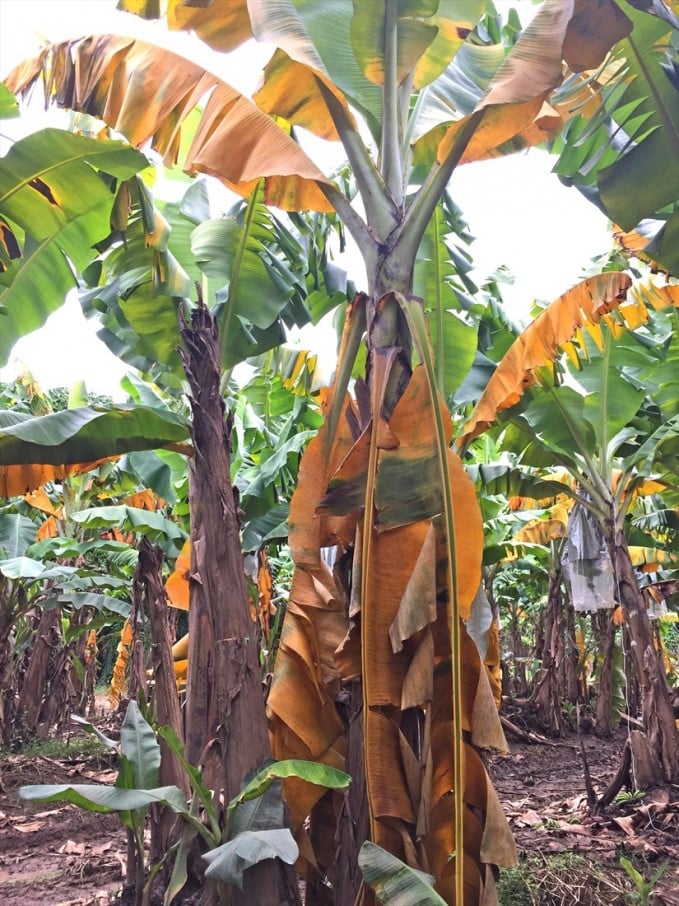
Banana leaf yellow disease is a dangerous disease that has wreaked havoc in many major banana-growing countries around the world. Photo: ST.
In order to actively prevent banana yellow leaf wilt disease, based on the results of the banana yellow leaf wilt investigation project supported by FAO, the Plant Protection Department has coordinated with the Fruit and Vegetable Research Institute, the Plant Protection Institute had added, developed and promulgated the Process of Integrated Management of banana leaf yellow wilt disease caused by Fusarium oxysporum f.sp.cubense (generally applicable to fungal strains) so that localities can disseminate, propagate and guide farmers to apply effective and safe disease prevention, contributing to promoting sustainable banana production.
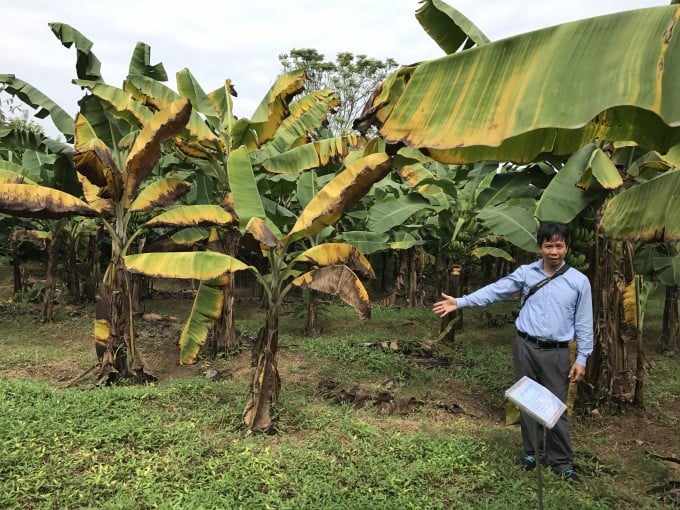
The Fruits and Vegetables Research Institute checked and showed that banana yellow wilt disease has appeared and damaged many banana growing provinces in our country. Photo: Favri.
Infected banana plants often show signs of yellowing from the old leaves below, then gradually spreading to the younger leaves. Yellow symptoms develop from the leaf margins and spread into the veins. Infected leaves are often wilted, have broken stems and leaves hang on the false stem, sometimes the petiole is also broken in the middle of the leaf blade.
On diseased plants, the old leaves are wilted around the pseudo-stem, leaving only a few leaves grow green and upright. These leaves are pale green or yellowish or distorted, wrinkled, and finally wilted.
The infected plant may die but the stem will not fall, the outer sheaths will be longitudinally cracked, the young shoots will still develop from the main stem but then also wither. Cutting the diseased stem horizontally will reveal the vascular bundles changed to yellow-brown, cutting across the real stem (banana’s rhizome) will show that the vessels are red-brown and smelly.
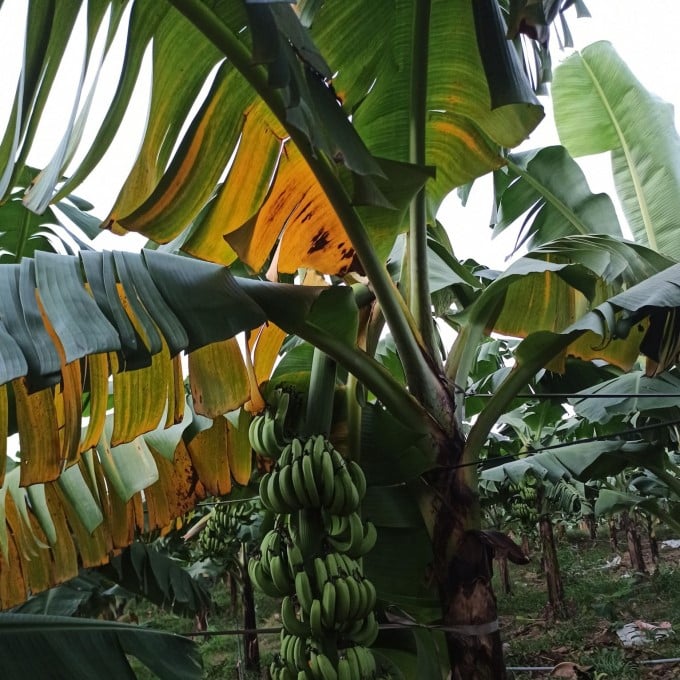
The prevention and control process against banana yellow leaf wilt disease is an important basis for localities to actively prevent diseases in production. Photo: TL.
Features of occurrence and development of the disease
Banana yellow leaf wilt is a disease that causes the gradual death of banana plants by fungi that invade, grow and cause damage in the conduction circuits.
When diseased banana plants die (death from disease or when harvested with rhizomes and roots left in the soil), spores (the reproductive organs of the diseased fungus) are released into the soil as the plant, rhizomes and roots decompose.
In the soil, fungal spores germinate and penetrate the cells of banana roots and develop into root-damaging mycelium. Fungi are more easily penetrated through mechanical wounds on the roots caused by nematodes and garden tools.
Secondary small roots or young roots will be infected first, then the fungus grows, follows the circuit leading to the main stem (banana rhizome) and goes up to the false stem (usually called banana stalk) to the petiole and the peduncle of the banana bunch, choking on nutrient conduction circuits, leading to undernutrition in banana, yellow leaves, underdeveloped fruit and plant death.
Effects of the disease
The disease causes the leaves to wilt from bottom to top, causing the banana plant to gradually die. Infected plants can produce shoots from the main stem, but these shoots will also wither so they cannot save the roots for the next crop or produce new seedlings.
Diseased trees are not usually harvestable, even if it is harvestable, the quality of the fruit is very poor. The disease spreads and causes serious damage to banana-growing areas with disease rates up to 80% if left untreated.
Translated by Samuel Pham

(VAN) GGGI commits to supporting stronger and closer cooperation between Vietnam and South Korea in the areas of green transition, information technology, agriculture and energy.
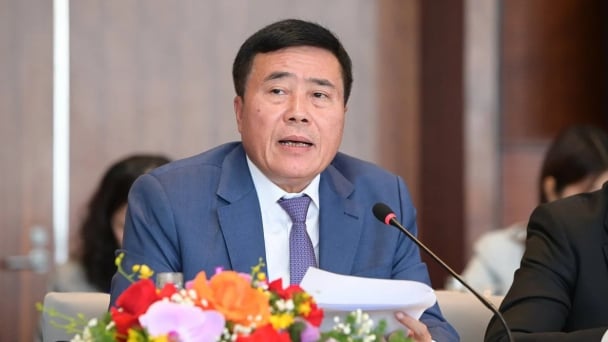
(VAN) Mr. Truong Sy Ba, Chairman of the Board of Directors of Tan Long Group, emphasized that future food security is not only about quantity, but also about being sufficient, appropriate, sustainable.

(VAN) Prime Minister Pham Minh Chinh sent a message of action and the principles of equal, fair, and responsible partnership in green growth at the opening ceremony of the P4G Summit.

(VAN) Leaders of Can Tho city emphasize three solutions for transforming food system towards green, low-emission, and sustainable development at the P4G Summit.

(VAN) On April 16, during the opening ceremony of the P4G Summit, P4G Chief Executive Robyn McGuckin announced that P4G will provide climate finance of 4,7 million USD to 17 innovative startups.

(VAN) Concluding the ministerial discussion session at the P4G Summit, Minister Do Duc Duy affirmed that transforming the food system is no longer a story of individual countries.
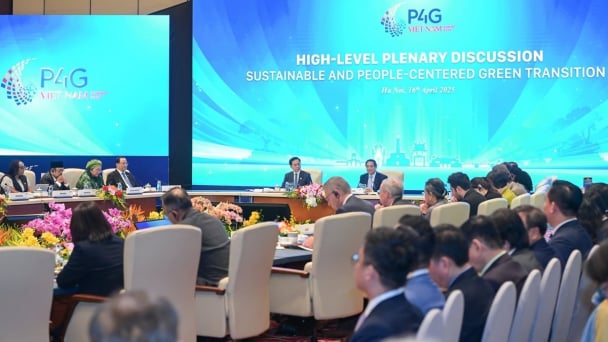
(VAN) On April 16, Prime Minister Pham Minh Chinh chaired the High-level Plenary Discussion themed 'Sustainable and people-centered green transition’ at the P4G Summit.